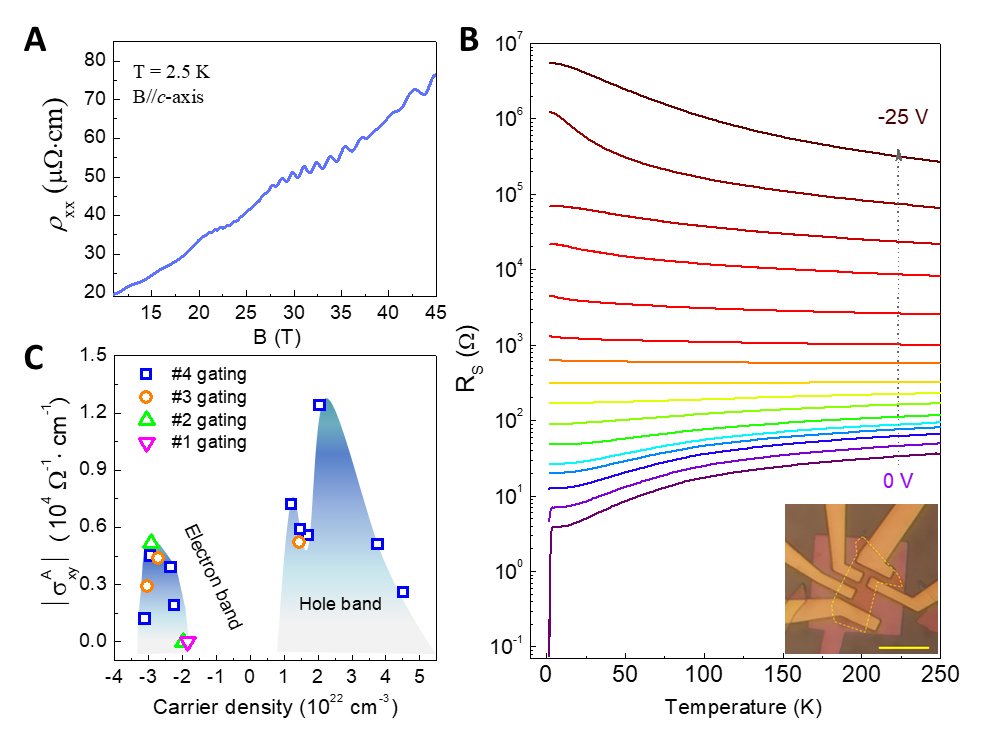
According to a paper published on Nature Communications recently, an international team observed the superconductivity-insulator transition (SIT) and greatly tuned the anomalous Hall effect (AHE) in kagome metal CsV3Sb5 flakes by protonic gating.
"For the first time, we uncovered a disorder-driven bosonic SIT and outlined a global picture of the giant AHE as well as its correlation with the unconventional charge density wave (CDW) in the AV3Sb5 family," said ZHENG Guolin from Chinese high magnetic field laboratory (CHMFL), Hefei Institutes of Physical Science (HFIPS), Chinese Academy of Sciences (CAS). He is the first author of the paper.
Topological kagome metals AV3Sb5 (A=K, Rb and Cs) exhibit rich physical properties due to the electronic correlations and topologically nontrivial band structures, including unconventional superconductivity, chiral CDW, and giant AHE. The unique coexistence of electronic correlations and band topology in AV3Sb5 allows for investigating possible quantum phase transition among these correlated electronic states through disorders, magnetic fields and electric fields. Moreover, the physical origin of the huge AHE and its correlation with CDW remains unresolved.
In this research, the team systemically studied the low-temperature transport properties of CsV3Sb5 nanoflakes with different thicknesses under protonic gate. It is found that proton intercalation-induced disorder can quickly suppress superconductivity in ultra-thin CsV3Sb5 nanosheets (within 25 nm), and the resistance-temperature (R-T) curve exhibits semiconductor behaviors at low temperatures.
At the higher gate voltage (>20 V), the sheet resistance of CsV3Sb5 nanoflakes at low temperatures reached up to 106 Ω, several orders larger than the quantum resistance value of the Cooper pair (~6450Ω), indicating the SIT under strong disorder. Unlike conventional insulators, however, the sheet resistance in insulating state exhibits a saturation trend for T →0 K, probably due to the incoherent tunneling between localized Cooper pairs.
For thicker CsV3Sb5 nanosheets (> 40 nm), the researchers found that a smaller gate voltage (<7V) would not change the superconducting transition temperature, i.e., disorder effects were greatly diminished. However, the slope of the low-temperature Hall resistance is continuously changed, suggesting a large tune of the carrier densities.
Further analysis revealed that the large AHE mainly occurred at the point M in the Brillouin zone with hole carrier density 2×1022 cm-3. Combined with theoretical analysis and first-principles calculations, the huge AHE in the system was mainly attributed to the skew scattering of holes in the flat band near the M point.
The work was financially supported by the National Key R&D Program of the MOST of China and the National Natural Science Foundation of China.

(A) The quantum oscillation of CsV3Sb5 single crystal under high magnetic fields.(B)The superconductor-insulator transition in untra-thin CsV3Sb5 nanosheets induced by proton intercalation.(C)The anomalous Hall conductivities under different carrier densities. (Image by ZHENG Guolin)